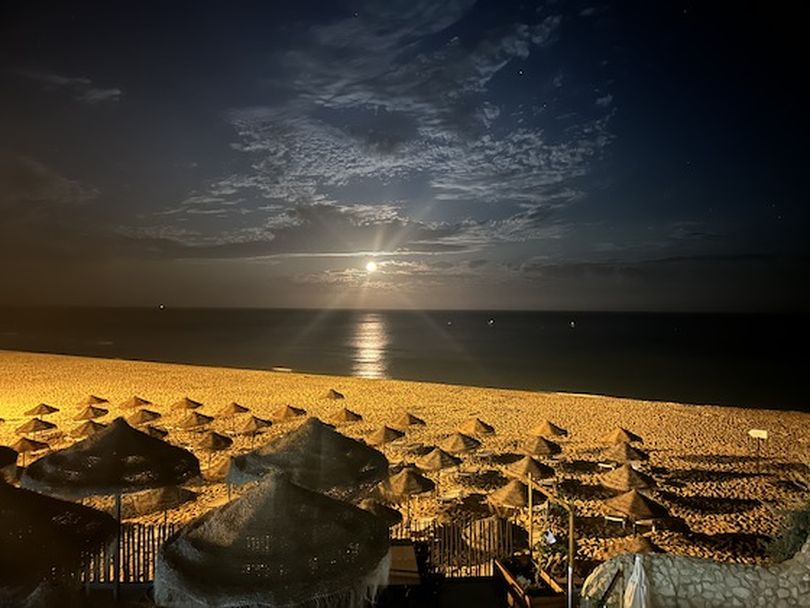Salema is a slice of Portuguese paradise

In December, during a visit to South Africa, my wife Mary Pat and I hired a driver to take us to the extreme end of the Cape of Good Hope – a spot that marks the southwestern-most point of the African continent. Though I know better, it truly did seem like the end of the world.
Then just this past June, we traveled to another foreign location that boasts its own unique geographical claim. It’s a spot that marks the southwestern-most point not just of Portugal but of continental Europe. The Cabo de São Vicente actually once was considered to be “the end of the world” – or so claims a souvenir T-shirt I ended up buying.
That presumption, of course, is enough hyperbole to make several million Antarctic penguins guffaw. But it seemed true enough to the Portuguese sailors – Henry the Navigator among them – who some five centuries ago first ventured out into the open Pacific Ocean. It was, for many of them, the last view of land that they would see.
But … I’m getting ahead of myself. When I left off my retelling of the trip that Mary Pat and I made to southern Spain and Portugal in late May and early June, we were still in the village of Nazaré, the beach town famous for its winter-season giant waves (see the Max series “100 Foot Wave”). We had driven to Nazaré from the northern city of Porto, and now we – along with our Spokane friends Ann and Matt – headed further south … to what is known as the Algarve.
If you’re curious about that name, it dates back to the era when nearly the whole of the Iberian Peninsula was under Muslim control. The Muslims referred to vast area they ruled as “Al-Andalus.” Algarve, then, comes from the Arabic word “Gharb al-Andalus,” which translates as “west of Al-Andalus.”
I drove from Nazaré to our ultimate destination, another Portuguese beach town, this one called Salema. As I’ve mentioned before, the roads in Portugal – particularly the major highway toll roads – are in excellent condition, and so the trip was easy. Still, it did take four hours to complete, forcing us to stop midway both to buy drinks and snacks, plus gas for our rental car. In the process of filling up, though, I almost gave the young woman at the service center a heart attack.
I went inside the center to get instructions from her about how to operate the gas pump. But then after finishing, I proceeded to move the car to a parking spot around the corner and out of her sight. Since I hadn’t yet paid, she thought I had driven off, leaving her to cover the 50-plus euro bill I’d run up. Mary Pat, who saw the woman’s distress, quickly assured her that I would return. Which, of course, I did … though not before I’d nearly caused an international incident. (Not for the first time, I should add.)
We arrived in Salema in the early afternoon. Our second-floor rooms at the Villamar, which were spacious, newly renovated and – best of all – air-conditioned – gave us an unobstructed view of the beach that includes Rick Steves (among others) as a fan.
“The town is blessed with a long, broad, gorgeous beach — luxurious with powder-fine sand, framed off by steep vivid-yellow cliffs, and relatively untrampled by rowdy tourists,” the Steves guidebook reports. “For my money, it may be the most purely enjoyable beach in all of Europe.”
Riiiight. I’m fairly certain the residents of Italy’s Cinque Terre would disagree. To be fair, though, Steves does warn that Salema can get crowded during the height of the summer season. But while there were a number of families present both on the beach and in the nearby plaza when we ventured out, we had no problem getting a table at the Atlantico restaurant, which is attached to the hotel – and at which we enjoyed a late lunch of sandwiches and cold drinks.
It was time then for a siesta. But I was too wired to just sit around, so I went for a walk. We would later discover that our hotel booking gave us access to beach chairs, umbrellas and towels. At the moment, though, I was more interested in finding some place that would serve me morning coffee. And I found it in the plaza, where the pasteleria Solmar – though closed just then – promised to be just what I needed the next day.
Our evening meal was not nearly as enjoyable. Mary Pat had managed to make a late dinner reservation at Restaurante O Lourenco, which was barely a 10-minute walk from our hotel and ranks on several websites among the best of Salema’s restaurants. But while the food wasn’t a problem (we actually ate barnacles, if you can believe it), and the servers were friendly enough, the place overall – at least on the night we ate there – felt understaffed and disorganized. Not our usual Portuguese dining experience at all.
Afterward, we called it a night and headed back to our rooms. The weather was perfect, which allowed us to have a clear view of the full moon rising over the ocean. We stood there on our terrace, listening to the drone of conversation coming from the diners below and looking at a sight that even a skilled artist would have trouble capturing.
Next up: Where the Navigator ruled.
